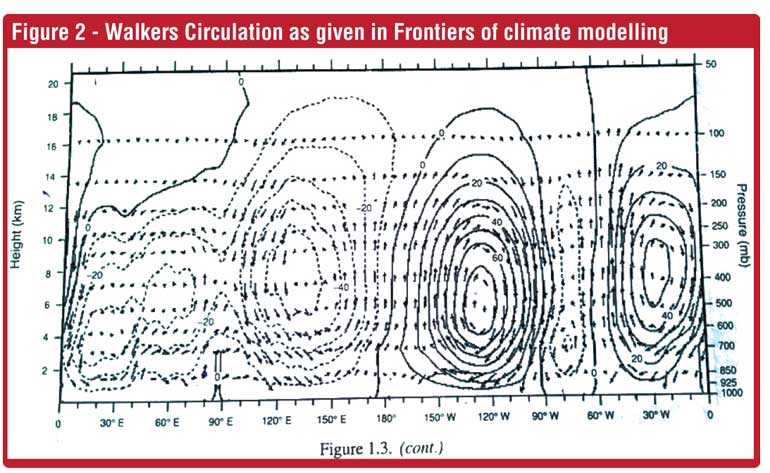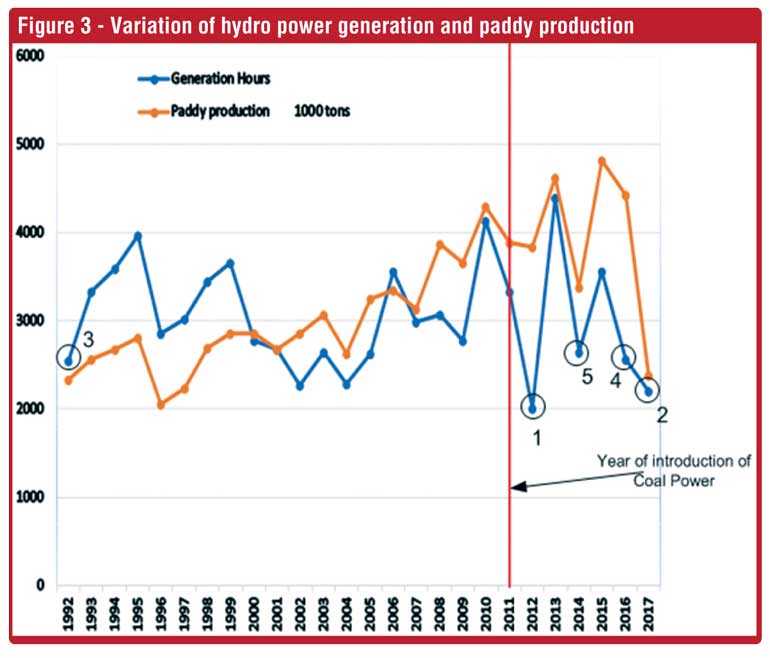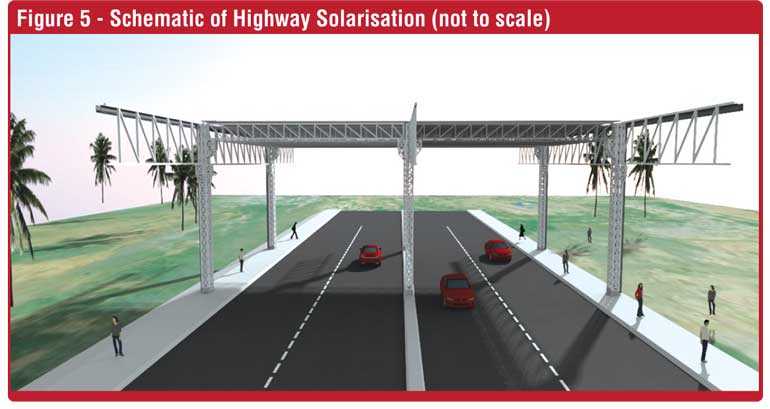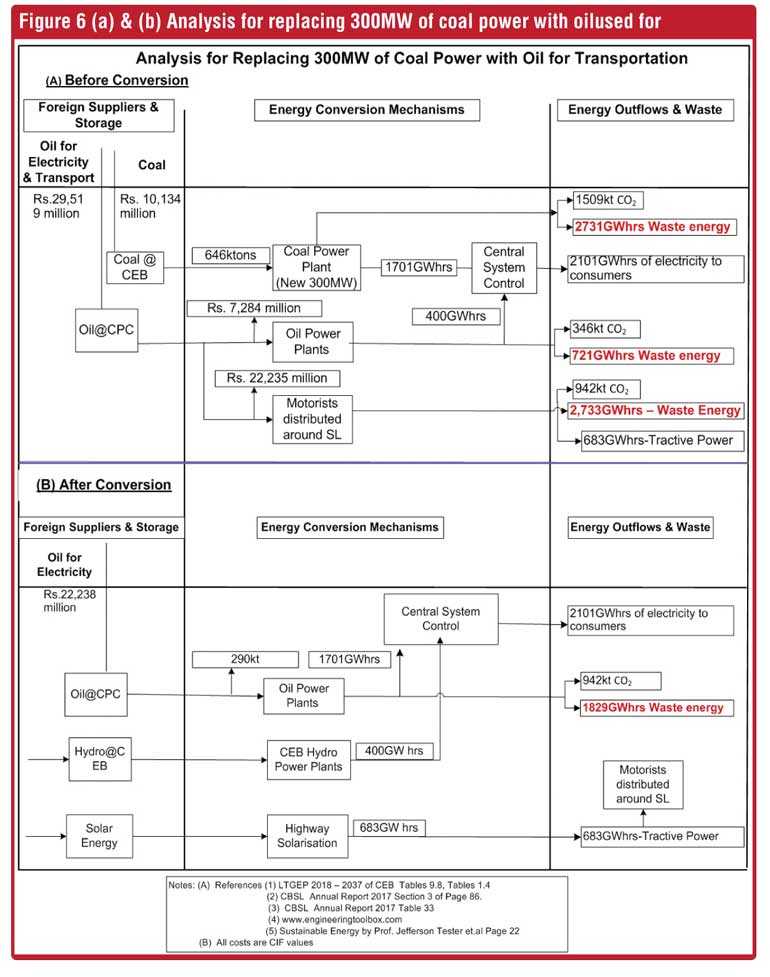Saturday Sep 13, 2025
Saturday Sep 13, 2025
Saturday, 2 June 2018 00:25 - - {{hitsCtrl.values.hits}}
If Sri Lanka implements the LTGEP, part of Sri Lanka will be a desert by 2040: 100% guaranteed. This is not vicious imagination, but the obvious conclusion if the following 10 scientific statements are true.
(a)In 2037, 23000GWhrs of electricity will be generated from coal (Based on LTGEP Fig 7.4).
(b)So, the additional CO2 emission from coal power will vary between 5049 kt in 2018 and 19249 kt in 2037 (LTGEP Table 9.9).
(c)With a land area of 65,000km2, this corresponds to a total increase of 250ppm of CO2 in the atmosphere.
(d)CO2 spends about 20 years in the atmosphere before it gets absorbed by vegetation or the oceans.
(e)Latitudinal atmospheric air circulation at 70 N – our latitude – is as per Hadley Circulation going up north towards 300N, drops moisture and comes down and back at 120 – 150 x 1099kg/sec (Figure 1.3a Frontiers of Climate Modeling)
(f)Longitudinal air circulation at 810E, - our longitude – is as per Walker Circulation at 0-10 x 109kg/sec (Figure 1.3b Frontiers of Climate Modeling).
(g)With present concentration of CO2 in the atmosphere, the atmospheric temperature increases approximately at 0.010C per ppm increase in CO2 concentration.
(h)For each degree rise in temperature atmosphere needs 7% more moisture to maintain constant relative humidity as per Clausius – Clapeyron Equation.
(i)Coal combustion does not generate moisture and as such this new moisture need to come from land surface – including waterways.
(j)So, this coal power generation is transferring our surface moisture to places in the north through a subtle form of pneumatic transport.
I would be most obliged if someone could show me where I have erred, as I have seven grandchildren and would like these to be false.

Our past experiences
We introduced coal power into our energy mix in 2011 – the same year the 150MW Upper Kothmale project was commissioned. During the last six years (2012-2017) we have experienced four of the lowest generation hours of our hydro since 1992. The graph below depicts this variation and the other noteworthy aspect is that our paddy production in 2017 was 2,036,000 tons (46%) less than in 2016 and 748,000 tons (24%) less than the lowest we have experienced since 2005. Exactly 748,000 tons of rice had been imported during 2017 at a cost of Rs. 45 billion.
The figures in the graph corresponding to 2000-2005 were extraordinary figures due to risk of reservoir walls been damaged by terrorists, etc. Ever since coalpower was introduced we had been expressing our concerns about hydro energy being compromised. We started computing hydroenergy generation hours because tracking hydrogeneration will not capture effect of coal power due to there been more hydro capacity added. In fact, Upper Kothmale hydrocapacity addition and coal power projects had been progressing hand in hand according to the CBSL Annual Report 2005. We have also calculated a five-year moving average for the generation hours and 2017 indicated a drop of 868 hours from the moving average which drop at 1384 MW hydro capacity is a loss of 1201GWhrs. In fact, this is the second time the generation hours in a year has been less than the five-year moving average during the previous five years, the first time being in 2012 immediately after the introduction of coal energy.
This is something we projected in August, 2016 and November, 2017 in this same paper with detailed explanation as to why this would happen.
In October, 2005 we published, in our newsletter “Quest for Excellence”, a definition of the word Consultant which rang as follows. (This may be the first time such a specific definition was put forward by any consultancy firm in the world.)
“Consultant is somebody (1) who provides advice on a particular subject, (ii) who provides all the necessary support on implementing this advice, (iii) whose predictions about positive outcomes from following this advice will come true and (iv) whose predictions about negative outcomes from not following this advice will also come true.”
Whatever I indicate in this article is covered by this definition and the reductions in hydrogeneration and paddy production experienced in 2017 do belong to the item (iv) in our definition mentioned above.
An alternative plan
There is no point in criticising a plan unless you can offer a better plan – at least we stick to this principle.
What CEB has produced as their Long Term Energy Generation Plan may be considered by CEB as the least cost plan for CEB. But as a Sri Lankan, I would like to see a least cost plan for Sri Lanka and since CEB is a state owned enterprise, they also should share that sentiment about the needs of the least cost plan.
So, if we are to prepare an Energy Generation Plan which would bring about the least cost for Sri Lanka, we need to look at all components in the Sri Lankan Energy Fabric. Here I would only consider the two major energy carriers, electricity and petroleum.
If we are to work out a least cost energy generation/conversion plan we need to understand how these two carriers provide Sri Lankans with the energy they need. To understand this, we prepared the flow chart given in Figure 4.
Energy waste in transport and electricity consumed
Looking at this, one could see a most frightening aspect in that waste energy from transportation is more than twice the total electricity supplied to the consumers. I calculated these two in 2010 July for USA using information given in Energy Outlook 2009 document of Energy Information Administration of USA and I found that the total waste from transportation was 13.5 Qn Btu while total electricity consumed was only 12.91 Qn Btu and that was a country where different cities are scattered in a total of 9.834 million sq.km. I calculated the same for the whole world in 2004 using data in IPCC’s Technical Assessment Report No. 4 of 2007 and found that the waste energy from transportation was 62.4 EJ while the global electricity used was 60.9 EJ. I presented these figures in slide 21 of the presentation I made at OPA – organised by Institution of Mechanical Engineers – on “Zero Emission Transportation – Sri Lankan Solution for Climate Change” on 21-12-2011. So, I was expecting the ratio between the two – electricity consumed and waste energy from transport – to be approximately one and I should categorically mention that this is an unbearable load on the poor masses of this country.
In 2017, we have wasted nearly Rs. 200 billion worth energy imported in oil and our indebtedness, as given in Table 118 of CBSL – 2017 report, has increased by nearly Rs. 1,000 billion so that 20% of the increase in our indebtedness arises from energy wasted in transportation. And that figure was based on a crude oil price of $ 58 per barrel and with a 25% increase in price already having come into being, it is definitely high time, we address this issue. We are already very much late.






Logic of the solution
The trend of increasing price of oil should prompt us more than ever in the past to delink our transportation from oil. But such delinking of our transport from oil should not be allowed to lead to displeasure in the minds of middle east leadership as we receive nearly 51.8% of remittances from overseas from that specific area. So, what we propose to-day as the fundamental principles of our least cost energy generation/conversion plan are (i) obtain tractive power for transportation from Highway Solarisation (defined as a dedicated infrastructure to generate electricity for powering battery electric vehicles or the Grid using solar energy collected by PV solar panels installed along and above the highways as a solution for climate change) where energy will be generated on the highway itself using solar energy and (ii) use that energy in oil made redundant to generate firm and dispatchable electricity to boost CEB’s capabilities. By doing this we could maintain our CO2 emissions approximately at their current levels, generate more electricity to match the needs of our development projects. According to the LTGEP it is envisaged that we would have about 2700MW power coming from coal in 2037. This implies an addition of about three times the current potential of 5731GWhrs in 2037 or 17193Gwhrs in 2037. If we convert all our transportation to be electrically driven – we already have electric cars, motorcycles, three wheelers, buses – in 2037, even with currently used amounts of oil for transportation we can generate 17,865 GWhrs.
The brief example
In order to depict how this would impact the finances of the CEB and Sri Lankan economy we have prepared two flow charts Figure 6- (A) and (B) one depicting the current plan with a new 300MW coal power plant added in 2023 and corresponding oil based transportation and the other with our suggested vehicle electrification, Highway Solarisation and electricity generation with the saved quantities of oil using a new Combined Cycle 300MW auto diesel generator as given in Table 9.8 of the LTGEP. The corresponding impacts of the change over on the finances of CEB and the Sri Lankan economy are also presented in a tabular form. What stems from these flow charts and the comparison table are as follows.
(1)The financial benefit to the CEB will be Rs. 7,636 billion while the net benefit to the country will be Rs. 16,680 billion.
(2)Waste heat emitted to the environment reduces from 6185 GWhrs to 1829 GWhrs.This is only in respect of one new coal power plant of 300MW capacity.
(3)CO2 emissions to the atmosphere reduce from 2797kt to 942kt. This again is only in respect of replacing one coal power plant of 300MW capacity.
When the entirety of current tractive power for transportation is provided by Highway Solarisation the new set up will be able to generate 17872GWhrs of new electricity and this should be able to substitute for 2700MW of anticipated coal power plants and bring about a saving of Rs. 120 billion per year.
(The writer is Managing Director of Somaratna Consultants Ltd.)
Cost-benefit analysis before and after replacing 300MW from a new coal power plant (2023) with oil
nThe principle of the conversion is (a) replacing power to be obtained from the planned new 300MW coal power plant (2023) with power from oil which would have got otherwise burnt for transportation and (b) providing energy for transportation using Highway Solarisation.
nWhile the situations prior to the replacement and after conversion are given in Figures 2A & 2B, the financial implications for CEB and Sri Lanka are given in the table.
From this comparison one could see that the implementation of this strategy will not only delink our transportation from oil in an environment of rising oil prices; but prevent our hydrogeneration and paddy production decreasing still further. A portion – say 25% - of the benefit which CEB will gain from this could be equitably distributed every year amongst the CEB Staff on a commemorative date on which CEB achieves this land mark event – a global first. We would also be reducing 4356GWhrs of waste energy and 1855kt of CO2 polluting the atmosphere above our 65000km2 island nation.
Fully-fledged plan
So, what we promote is use the energy in the oil we import today for transportation for conversion into electricity and obtain tractive power for transportation from Highway Solarisation. The brief example shown above demonstrates that it would be more beneficial to the CEB as well as to the country.
If we could implement that plan we would be saving Rs. 130 billion worth of energy in oil as electricity and without this plan it would have just gone waste. And this cost of oil is only destined to go up as global price of oil moves up toward $100 per barrel and beyond.
An approximate time plan
Since the first 300MW coal power plant is scheduled to come on line in 2023, we have five years to bring these plans also into effect. A 300MW Combined Cycle Auto Diesel Plant can be erected and commissioned much faster than a coal power plant with so many uncertainties regarding location, coal unloading arrangements, etc. On the other hand, generating 683 GWhrs/year of electricity by Highway Solarisation would involve a 450MW arrangement which might use about 150kms of 22ft roadway. Unlike in the case of thermal power plants, Highway Solarisation could be implemented in a staggered fashion, say 50MW at a time. These projects could be awarded to different investors and contractors with a common set of specifications.
It would be best that electric vehicle population in the country also increases in line with this progress in Highway Solarisation. Availability of Battery Electric Vehicles should improve as both individual countries and vehicle manufacturers are announcing very ambitious targets for their usage percentages and manufacturing levels. Furthermore, when this process of Highway Solarisation catches up one could expect an exponential increase in the use of battery electric vehicles.
 Implementation party
Implementation party
Of course, the other issue which will arise is who is going to implement this Highway Solarisation project. It was in July, 2010, in the aftermath of Deepwater Horizon, I suggested to US Department of Energy to get British Petroleum to implement Highway Solarisation in USA when BP was paying US$ 20 billion to compensate for Deepwater Horizon disaster. Even in Sri Lanka, we wrote an article titled “Making both CEB and CPC profitable at the same time” in Daily FT (13-12-2013) suggesting that CPC implements Highway Solarisation and sells electricity to CEB who in turn will transmit and sell it for charging. At that time, I was expecting CEB to sell it to charging stations; but after listening to the Throne Speech – 2018 in UK wherein they divulged their plan to encourage petrol filling stations to provide battery charging for Battery Electric Vehicles, I thought that we in Sri Lanka can do the same thing. Then the model will be CPC puts up the Highway Solarisation (after all they were planning to put up an oil refinery at a cost of $ 1.5 to 2 billion in an environment where even the Fortune Magazine’s list of 25 industries that an investor should not put any money in published in 2015 included oil refineries) and sells electricity to CEB at a decent price who will transmit it to charging stations established at petrol filling stations or elsewhere and CPC maintains a joint franchise with CEB on the same.
Once we decide on the arrangement for the sake of saving Sri Lanka from becoming a desert or from been hammered by Climate Change, we could always get the relevant economists and planners work out the modalities. The President’s own team of economic experts – wonder whether they approved getting an oil refinery established here with aid from Iran – and Prime Minister’s own team of experts could assist in this initiative.
Conclusion
We are currently facing two grave problems associated with fossil fuel usage in Sri Lanka in that (i) anymore coal power plants will definitely expedite “Part of Sri Lanka becoming a desert” process and reduce our paddy production on one hand and hydrogeneration on the other and (ii) oil imported for transportation and wasted has become to represent the worst case in the whole world.
Even with these two strains on our economy, we are fortunate to have one single solution with two arms – one to generate electricity using Highway Solarisation for providing electricity to electric vehicles and the other based on using that amount of oil made redundant to generate firm and dispatchable electricity.